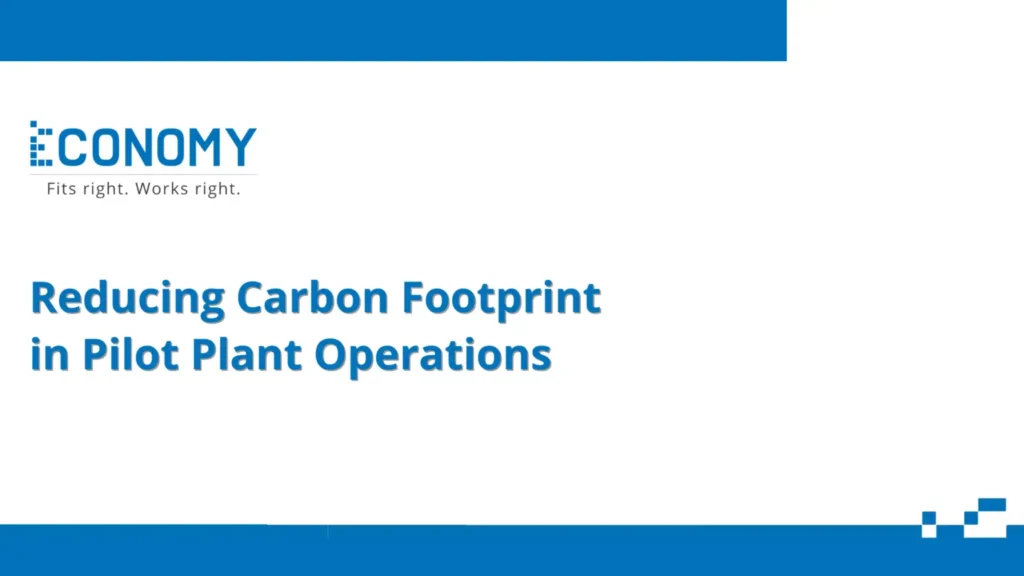Reducing the carbon footprint in pilot plant operations is becoming increasingly critical as industries seek to minimize environmental impact. Pilot plants, which serve as intermediate-scale models of full-scale production systems, offer an ideal setting for optimizing energy efficiency and sustainability. In the context of process industries, where energy-intensive separation and purification techniques are frequently employed, adopting sustainable practices can significantly lower carbon emissions. This article outlines strategies for reducing the carbon footprint in specific pilot plant operations, including Liquid-Liquid Extractor (LLE) plants, Rising and Falling Film Evaporators, Single Stage Short Path Distillation Units (SPDU), Agitated Thin Film Evaporators (ATFE), Agitated Thin Film Dryers (ATFD), and Lab Evaporator Set-ups.
1. Liquid-Liquid Extractor (LLE) Pilot Plant
Liquid-liquid extraction is widely used to separate compounds based on their solubility in different immiscible liquids. This method can be energy-intensive due to the need for heating, pumping, and phase separation.
- Energy Optimization: To reduce energy consumption, focus on optimizing the design and operation of the extractor. The use of energy-efficient pumps and motors, along with automated controls, can significantly cut energy use. Additionally, consider using low-energy solvents that require less heat to separate or process.
- Process Intensification: Implementing process intensification methods, such as combining extraction and distillation into a single unit operation, can minimize energy input by reducing the number of steps involved.
- Waste Minimization and Solvent Recycling: Employ solvent recovery systems to reuse solvents, minimizing waste and reducing the energy required for solvent production. This not only reduces emissions from the production of new solvents but also cuts disposal costs.
2. Rising Film and Falling Film Evaporator Pilot Plants
Rising Film & Falling Film Evaporator Pilot Plant are widely used for concentrating solutions by evaporating the solvent. These processes often involve high energy consumption due to the need to supply heat for evaporation.
- Efficient Heat Sources: One of the most effective ways to reduce the carbon footprint in evaporator operations is by utilizing energy-efficient heat sources. Where possible, incorporate renewable energy sources, such as solar thermal systems, or waste heat recovery from other parts of the plant to provide the necessary heat for evaporation.
- Thermal Vapor Recompression (TVR): TVR is a technology that compresses and recycles vapor within the system, reducing the amount of fresh steam required. This can drastically cut down energy use, particularly in high-capacity operations.
- Optimizing Operation Parameters: By operating the evaporators at optimal temperatures and pressures, energy consumption can be reduced. Employing automated control systems ensures that the equipment operates under the most energy-efficient conditions at all times.
3. Single Stage Short Path Distillation Unit (SPDU) Pilot Plant
Short path distillation is a highly efficient separation technique used for purifying sensitive compounds. While it is already considered an energy-efficient process due to its operation at low pressures, there are still opportunities for further reducing its carbon footprint.
- Vacuum Optimization: Minimizing the energy used by vacuum pumps is key in short path distillation. Utilize energy-efficient vacuum pumps with variable speed drives (VSDs), which adjust the pump’s speed based on the system’s demand. This reduces energy use when full pump capacity is not required.
- Heat Integration: Implementing heat integration strategies, where heat generated in one process is used to supply another part of the plant, can significantly reduce overall energy consumption. This is particularly useful in distillation processes where both heating and cooling are required.
4. Agitated Thin Film Evaporator (ATFE) Pilot Plant
Agitated Thin Film Evaporators are highly effective for concentrating heat-sensitive materials. While they are generally energy-efficient, additional measures can further reduce their carbon footprint.
- High-Efficiency Motors and Drives: The agitation mechanism is a key energy consumer in ATFEs. Replacing standard motors with high-efficiency models, and adding variable frequency drives (VFDs), can significantly cut energy use by adjusting the agitation speed to match the process requirements.
- Waste Heat Recovery: Incorporating waste heat recovery systems to capture and reuse excess heat from the evaporation process can lower energy demand. The recovered heat can be used for pre-heating feedstock, further reducing the overall carbon footprint.
5. Agitated Thin Film Dryer (ATFD) Pilot Plant
Agitated Thin Film Dryers are used to dry viscous liquids or slurries. They are energy-intensive due to the heat required to evaporate the solvent.
- Solar or Waste Heat Drying: Replacing conventional heating systems with solar-assisted drying or integrating waste heat recovery systems can substantially reduce the carbon footprint. Solar thermal systems are especially beneficial in areas with high solar insolation.
- Efficient Design and Insulation: Optimizing the design to ensure minimal heat losses and adding advanced insulation materials can significantly reduce energy consumption. Using energy-efficient heat exchangers also enhances thermal efficiency.
6. Lab Evaporator Set-Up Pilot Plant
Lab evaporators are essential for small-scale research and development, but they also offer opportunities for energy optimization and carbon footprint reduction.
- Use of Closed-Loop Cooling Systems: Lab evaporators often use water cooling, which can be wasteful. Implementing closed-loop cooling systems minimizes water use and reduces the energy required for cooling.
- Energy-Efficient Heating Baths: Heating baths are a common energy consumer in lab evaporators. Switching to energy-efficient models, such as those with rapid heat-up times and precise temperature control, reduces energy use.
Conclusion
Reducing the carbon footprint of pilot plant operations involves both optimizing the energy consumption of equipment and integrating sustainable practices into the process. In Liquid-Liquid Extractors, optimizing solvent use and recycling are key strategies, while in evaporators and dryers, adopting energy-efficient heating, recovery systems, and process control measures can significantly lower emissions. As pilot plants often serve as testing grounds for large-scale production, incorporating sustainable design and operational strategies here can influence full-scale operations, leading to broader environmental benefits across industries.



